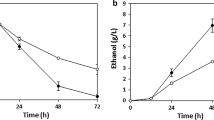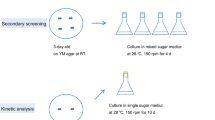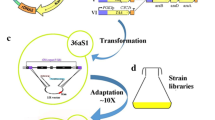Abstract
In order to construct a strain that converts sugar mixture and resist/metabolize inhibitors in lignocellulosic dilute-acid hydrolysate, the biotechnology of inactive intergeneric fusion between Saccharomyces cerevisiae and Pachysolen tannophilis was performed. Fusant 1 was successfully obtained as a hybrid strain, which was screened out by xylose and mixed sugar (xylose and glucose) fermentation. This strain showed good abilities of ethanol production, ethanol tolerance, and resistance to the toxic inhibitors presenting in the hydrolysate. The maximum volumetric yield of ethanol and yield of xylitol in mixed sugar was 9.52 g/l and 0.44 g/g, respectively. The results indicated that the constructed strain Fusant 1 was a good producer for ethanol and xylitol from lignocellulosic dilute-acid hydrolysate.




Similar content being viewed by others
References
Aristos, A., & Merja, P. (2000). Metabolic engineering applications to renewable resource utilization. Current Opinion in Biotechnology, 11, 187–198. doi:10.1016/S0958-1669(00)00085-9.
Saha, B. C. (2003). Hemicellulose bioconversion. Journal of Industrial Microbiology, 30, 279–291. doi:10.1007/s10295-003-0049-x.
Satoshi, K., Atsuko, M., Hideki, F., & Akihiko, K. (2006). Ethanol fermentation from lignocellulosic hydrolysate by a recombinant xylose- and cellooligosaccharide-assimilating yeast strain. Applied Microbiology and Biotechnology, 72, 1136–1143. doi:10.1007/s00253-006-0402-x.
Klinke, H. B., Thomsen, A. B., & Ahring, B. K. (2004). Inhibition of ethanol-producing yeast and bacteria by degradation products during pre-treatment of biomass. Applied Microbiology and Biotechnology, 66, 10–26. doi:10.1007/s00253-004-1642-2.
Heluane, H. (1993). Characterization of hybrids obtained by protoplast fusion between Pachysolen tannophilis and Saccharomyces cerevisiae. Applied Microbiology and Biotechnology, 40, 98–100. doi:10.1007/BF00170435.
Jhannsan, E., Eagal, L., & Brendenhann, G. (1985). Protoplast fusion used for the construction of presumptive ploypiods of the D-xylose fermenting yeast Candida shehatae. Current Genetics, 9, 313–319. doi:10.1007/BF00419961.
Kordowska, W. M., & Targonski, Z. (2001). Application of Saccharomyces cerevisiae and Pichia stipitis karyoduction to the production of ethanol from xylose. Acta Microbiologica Polonica, 50, 291–299.
Ferencezy, L., Kevei, F., & Zsolt, J. (1974). Fusion of fungal Protoplast. Nature, 248, 793–794. doi:10.1038/248793a0.
Kao, K. N., & Michayluk, M. R. A. (1974). Method for high frequency intergeneric fusion of plant protoplasts. Planta, 115, 355–367. doi:10.1007/BF00388618.
Perberdy, J. F. (1980). Protoplast fusion—a tool for genetic manipulation and breeding industrial microorganisms. Enzyme and Microbial Technology, 2, 23–29. doi:10.1016/0141-0229(80)90004-6.
Zimmermann, U., & Pilwat, G. (1978). The relevance of electric field induced changes in the membrane structure to basic membraneresearch and clinical therapeutics and diagnosis. In: Abstract of the 6th International Biophysics Congress Kyoto, IV-19-(H):140
Ferenczy, L. (1984). Fungal protoplast fusion. In R. F. Beers Jr, & E. G. Bassett (Eds.), Cell fusion: Gene transfer and transformation. New York: Raveb Oressam.
Wright, W. E. (1978). The isolation of heterokaryons and hybrids by a selective system using irreversible biochemical inhibitors. Experimental Cell Research, 112, 395–407. doi:10.1016/0014-4827(78)90222-7.
Fodor, K. (1978). Journal of Bacteriology, 135(1), 68–70.
Acknowledgments
We would like to thank the Ministry of Science and Technology for financial support (nos. 2001AA514024 and 2002AA514010). We gratefully acknowledge the Department of Energy Chemical Engineering (East China University of Science and Technology, Shanghai, China) for providing the hydrolysate used in the experiment.
Author information
Authors and Affiliations
Corresponding author
Additional information
F. Yan, F. Bai, and S. Tian contributed equally to this research work.
Rights and permissions
About this article
Cite this article
Yan, F., Bai, F., Tian, S. et al. Strain Construction for Ethanol Production from Dilute-Acid Lignocellulosic Hydrolysate. Appl Biochem Biotechnol 157, 473–482 (2009). https://doi.org/10.1007/s12010-008-8343-8
Received:
Accepted:
Published:
Issue Date:
DOI: https://doi.org/10.1007/s12010-008-8343-8




